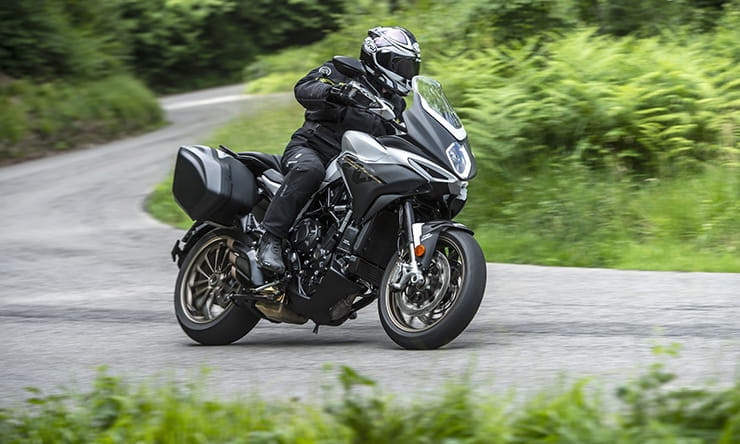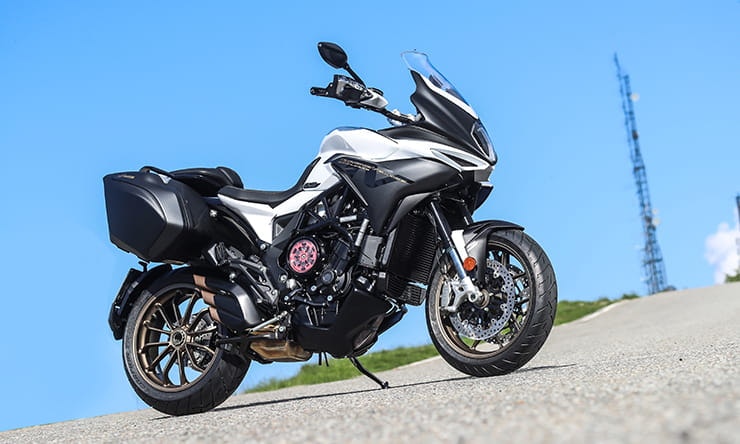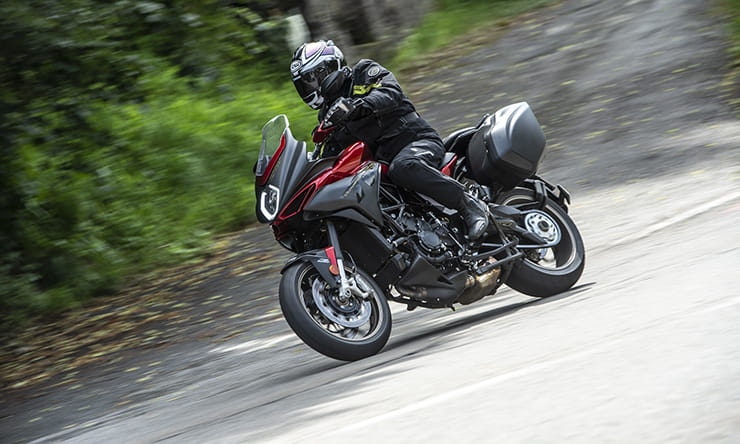MV Agusta Turismo Veloce 800 Lusso SCS (2018) - Review
By Simon Hancocks
Motorcycle Journalist
15.06.2018
The Turismo Veloce 800 Lusso is MV’s second try at a bike that, MV president, Giovanni Castiglioni assured me is ‘not a tourer’. Well, if this tall, three cylinder, part faired bike isn’t a tourer, what is it? ‘The Turismo Veloce is a sportsbike for everyday’ he responds, ‘It’s the MV Agusta F3 you can ride to work on.’
To me it still fits best in the sports/touring segment better than any other but that’s not the full story. We have travelled to Italy to ride two bikes, one is an update of the Turismo Veloce, released in 2015, that now includes Sachs Skyhook electronic suspension. The other, called the SCS (Smart Clutch System) features a hi-tech Rekluse clutch meaning, if you didn’t want to, you’d never need to pull the clutch in again – ever.
Price
The standard Turismo Veloce Lusso is priced at £17,990 while the SCS comes in at £19,000. While this does make the two bikes the most expensive in the 800cc sports/sports touring market, (Yamaha’s Tracer 900GT would be the closest comparison at about £11k!) you can’t really be surprised. MV aren’t renowned for making cheap, inexpensive bikes for shy retiring riders.
Power and torque
Both bikes make a claimed 110hp at 10,150rpm and 80Nm or torque at 7,100rpm. The engine gets better as the revs climb higher; keep the revs above 4000rpm for optimum 3rd/4th gear overtakes. The torque curve is unmistakable, triples have a wide fat torque curve that offers some shove regardless of the gear you’re in. The Turismo Veloce is no exception. In fact; the SCS bike will pull away – albeit slowly – in 3rd gear. There aren’t many other bikes from this part of the world that can do that!
Engine and exhaust
At the heart of the bike is a 798cc, 12-valve engine that has a MotoGP inspired counter rotating crankshaft. The cranks rotational direction counteracts the centripetal force of the wheels, making the bike turn faster. It really does work. Flicking the bike from ear to ear on the tight twisty roads, I could have sworn I was riding a head-down sportsbike.
MV have worked hard with this bike to get through the latest Euro4 regulations without losing any of the bike’s power or character. Proof of this if needed that the 2018 bike makes the same power as the bike released in 2015, despite much more stringent noise and emissions regulations imposed by the fun-police in Brussells.
On the fast flowing mountain roads around the factory I found the engine to be really eager, it loves to be run right up to the redline. MV have also done a superb job of making an engine that is extremely tractable and easy to ride in town, a good job really as not everyone lives at the bottom of the roads we ran on the launch; most have to ride to the good roads first. The feel of the flyby-wire throttle is excellent with no glitches or fluffs from the engine even when making tiny adjustments to the bike’s speed. As with all triples, the engine is as silky smooth as MV’s flowing lines and even at motorway speeds remains vibe-free and comfortable.
Crowning the right-hand-side of the bike is MV’s signature (for the 800cc bikes anyway) triple tipped, underslung silencer. The square tips are aimed slightly lower than those on the Brutale 800 to aid long distance comfort for rider and passenger. The bike sounds lovely, with a rasping exhaust note that comes into its own at about 3.500rpm. Another hi-five to MV for the way they’ve gone about Euro4’s noise regulations. Instead of simply slapping a huge silencer on the Turismo Veloce, they have instead worked at reducing all the other noise the engine makes, leaving the exhaust to sing its song. At tickover and on the move there is no cam-chain rattle, tappets noise, gear or clutch whine, instead all you can hear is the exhaust and a whiff of induction howl – bellisimo!
Economy
With no opportunity to test the MPG on the launch – the bikes were filled at the start and didn’t need refuelling after two 130km laps – I’m only able to quote MV’s claimed MPG figure of 5.8 litres per 100km or about 40mpg. While that doesn’t make it the most frugal of bikes on the market, it’s larger than average, 21.5 litre tank should mean about 400km or 250miles between fill-ups.
The trouble is, MPG and economy isn’t calculated in the real world, where switchback hairpins and a front wheel hovering four inches off the floor tend to ruin the calculations.
Handling, suspension, chassis and weight
As with any MV, the chassis that cradles the Turismo Veloce is a work of art. All the frame building and welding is done by hand. And it looks every-inch the Italian thoroughbred. The front half is an all steel tubular trellis with cast sections either side of the footpegs that carrying swingarm. The rake and trail of the bike make it as fast turning and flickable as anything I’ve ridden. Carving the bike through the sweeping bends through Acrumeggia made you forget you were riding a bike with two-up potential and panniers that’d house two XXL Arais.
Trying to keep the rubber on the Tarmac up front you have 43mm Sachs Skyhook USD forks. The Skyhook system has been around for a while and is well tuned keeping the bike noticeably stable when braking from motorway speeds. I did find the front end to be slightly soft but never felt them bottoming out. It was more excessive dive in the initial part of braking, then the suspension would work it all out and level the bike off. If I had more time and miles it’d be possible to dial this out via the – slightly clumsy – dash settings, or fork adjusters.
At 192kg dry the Turismo Veloce isn’t what you’d call heavy but it is a very slim and quite tall bike meaning a heave off the stand is needed when not on a flat surface. I wasn’t the only person on the launch who found slow seed control tricky – a bike being paddled around on tiptoes was a common site at the photo stops! When out on the move though the bike is light on its feet and a pleasure to ride. As a guide I’m 5’7”, if you are any shorter than that, this bike may be a struggle for you.
Brakes
Up front are Brembo four-piston calipers and 320mm discs which are good, but not great. There is plenty of braking power but not a lot of feedback through the lever. The Tourismo Veloce’s front brake is much more Turismo (touring) than Veloce (fast).
At the rear is a single two piston caliper and 220mm disc. As with most modern sportsbikes, the back brake was mainly redundant other than when manoeuvring but when needed it worked well.
I only felt the Bosch ABS cutting in once on the launch; when braking from motorway speeds down to a give way sign. The ABS cut in smoothly although the backend of the bike fishtailed slightly, just before I came to a stop.
Comfort
Massive thumbs up to MV on this front; the Turismo Veloce is one of the comfiest bikes I have ridden. The reach to the bars is spot on, pegs are set lower than my long-term Multistrada and the riding position is comfortable for six-hours at least – we rode from 9:30 till 5:00pm and I could have easily carried on.
The seat is extremely plush and soft, with the perforated leather finish offering great support. The pillion seat is also adorned with a large pad on the front edge of it which helps to bolster you when accelerating hard.
Equipment
The one slightly annoying feature with the bike is that it has all the equipment you’d need – heated grips, cruise control, switchable ABS, riding modes and all the trips and riding stats you’d expect – It’s just really hard to use. Okay, so I might be being unfair; if you bought one you’d spend hours reading the manual but on a launch, you have to jump on and go.
I found the heated grips and cruise control difficult to find and use, the riding modes were okay when you knew where to go but would be impossible to change on the fly. It could just be like switching from iPhone to Android but, I have found other manufacturers interfaces much easier to use.
Another nod to the machines sporty DNA is the addition of an app that links to the bike via Bluetooth. It allows you to download stats of your ride including speed, throttle position, route and a whole host of other data to pour over once you have reached you destination. It's a cool feature and one that you would only normally find on top flight superbikes. Linking your phone to the bike is a fairly simple process and the data downloads in about five to ten minutes, depending on how long the ride was.
What is a Rekluse clutch?
Take a look at how a Rekluse clutch works
What is a Rekluse clutch?
The SCS system uses something called a Rekluse clutch, which has been around in the motocross world for years, they just aren’t very well known outside of these circles. The premise is that when the bike engine starts, regardless of whether you’re in neutral or sixth, the clutch will keep the engine’s torque from reaching the gearbox. It’s a bit like the go-karts you drive that have the engines ticking over when you get into them but only pull away when you step on the throttle, the clutch will only transmit the torque from engine to gearbox when a certain RPM is reached.
One thing the clutch on the MV does much better than the go-karts at the local arrive-and-drive is it’s linked to the bikes ECU. This means the clutch has electronic intervention that allows it to optimise your get away based on revs, gear and throttle position.
I’ve not been a massive fan of DCT (Honda’s take on this kind of engineering solution) and found the SCS to be a massive improvement. It’s so much more natural, accurate and user friendly. It also gives the rider the choice between using the clutch and ignoring it. Stopping in town and not pulling in the clutch does feel weird at first but once you have got used to it, it’s a welcome relief and one less thing to worry about when you’re dodging Italian taxi drivers!
Launch control…
That’s right, the SCS equipped Turismo Veloce 800 Lusso has a kind of launch control built in. And it’ll propel the this comfortable, stunning looking and nimble bike to 60mph in a claimed 3.1seconds – MV are quick to note that’s quicker than some top flight World Superbikes.
Testing this was an odd feeling. “Just put it in first (gear) and pin the throttle” said Brian Gillen, MV’s Technical Director. “That just feels ****ing weird” I respond. I’ve spent the last six years learning how to meter the throttle of a bike to keep me out the hedge. Now a chap I’ve just met is telling me to forget all that, pin it to the stop, and trust the (Italian) electronics…
Well as you’re reading this, I survived and those electronics are truly phenomenal. The ECU and all those zeros and ones will set the wheel about four to six inches above the tarmac and just keep it there. Even the upshifts through the ‘box do nothing to stop levitation act. It’s one of the most impressive things I’ve been lucky enough to encounter on two wheels – Bravo MV.
MV Agusta Turismo Veloce Lusso 800 SCS verdict
This bike is a jewel, it’s a stunningly built, ferociously fast machine. Created by an artisan workforce that are as passionate about their bikes as any of us two-wheeled petrol-heads that ride them. The problem I have is that the Turismo Veloce is supposed to be a sportsbike for everyday use. But I just can’t see that happening, it’s too nice, too pretty and too MV to use every day.
The MV tag-line that adorns the walls of the factory is ‘Motorcycle Art’. And this bike is just that. If I bought one I’d spend as much time gawping at it in the garage as I would riding it – it is a stunning piece of automotive engineering. But all those jewel-like details come at a price – nearly £20k for the SCS – but in a sector that is dominated by touring machines that have evolved from nakeds, (Tracer 900GT and the like) the MV is a genuinely interesting take on the sports touring motorcycle. Starting with a sportsbike and making it more comfortable and useable is such a simple idea and in this format, it absolutely works.
It isn’t without it’s niggles though, a TFT dash at this price bracket should be standard and lower seat would be nice but, give it a hundred miles with some good roads and all those niggles will fade away, very quickly.
Three things I loved about the Turismo Veloce 800 Lusso SCS…
• Styling
• Acceleration
• Auto-clutch that actually works
Three things that I didn’t…
• Dash
• Seat height – on the tall side
• Front brake feel
MV Agusta Turismo Veloce 800 Lusso SCS spec
To insure this bike, click here


